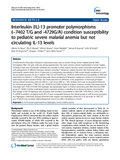| dc.contributor.author | Okeyo, Winnie A | |
| dc.contributor.author | Munde, Elly O | |
| dc.contributor.author | Okumu, Wilson | |
| dc.contributor.author | Raballah, Evans | |
| dc.contributor.author | Anyona, Samuel B | |
| dc.contributor.author | Vulule, John M | |
| dc.contributor.author | Ong’echa, John M | |
| dc.contributor.author | Perkins, Douglas J | |
| dc.contributor.author | Ouma, Collins | |
| dc.date.accessioned | 2023-12-02T10:53:48Z | |
| dc.date.available | 2023-12-02T10:53:48Z | |
| dc.date.issued | 2013-03-25 | |
| dc.identifier.uri | https://doi.org/10.1186/1471-2172-14-15 | |
| dc.identifier.uri | https://link.springer.com/article/10.1186/1471-2172-14-15 | |
| dc.identifier.uri | http://ir-library.mmust.ac.ke:8080/xmlui/handle/123456789/2413 | |
| dc.description.abstract | n holoendemic Plasmodium falciparum transmission areas such as western Kenya, severe malarial anemia [SMA, hemoglobin (Hb) < 6.0 g/dL, with any density parasitemia] is the most common clinical manifestation of severe malaria resulting in high rates of pediatric morbidity and mortality in these regions. Previous studies associated interleukin (IL)-13 with pathogenesis of different infectious diseases, including P. falciparum malaria. However, the functional roles of polymorphic variants within the IL-13 promoter in conditioning susceptibility to SMA remain largely unexplored. As such, the association between the IL-13 variants -7402 T/G (rs7719175) and -4729G/A (rs3091307) and susceptibility to SMA was determined in children (n = 387) presenting with clinical symptoms of falciparum malaria and resident in a holoendemic transmission region in western Kenya. Our results indicated no difference in the proportions of individual genotypes among children presenting with non-SMA (n = 222) versus SMA (n = 165). Similarly, there was no associations between the individual genotypes (-7402 T/G and -4729G/A) and SMA. Additional analyses, however, revealed that proportions of individuals with -7402 T/-4729A (TA) haplotype was significantly higher in children presenting with SMA than non-SMA group (P = 0.043). A further multivariate logistic regression analyses, controlling for confounding factors, demonstrated that carriage of the TA haplotype was associated with increased susceptibility to SMA (OR; 1.564, 95% CI; 1.023-2.389, P = 0.039). In addition, circulating levels of IL-13 were comparable between the clinical groups as well as across genotypes and haplotypes. Collectively, findings presented here suggest that haplotypes within the IL-13 promoter at -7402 T/G and -4729G/A may modulate SMA pathogenesis, but do not affect circulating IL-13 levels. | en_US |
| dc.language.iso | en | en_US |
| dc.publisher | BMC Imunology | en_US |
| dc.subject | Interleukin (IL)-13, promoter, polymorphisms, (-7402 T/G ,4729G/A) ,condition, susceptibility, pediatric, severe, malarial, anemia,circulating, IL-13, levels | en_US |
| dc.title | Interleukin (IL)-13 promoter polymorphisms (-7402 T/G and -4729G/A) condition susceptibility to pediatric severe malarial anemia but not circulating IL-13 levels | en_US |
| dc.type | Article | en_US |

